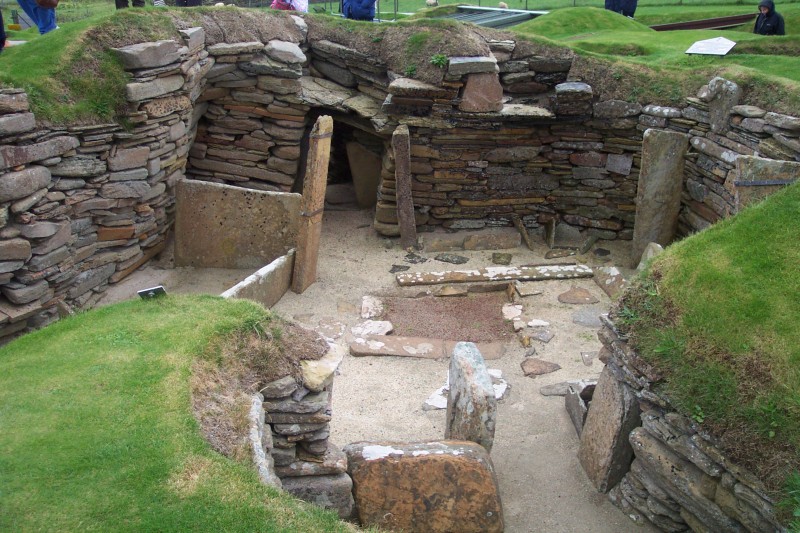|
Marion Campbell (archaeologist)
Marion Campbell (c. 16 December 1919 - 13 June 2000) was a Scottish archaeologist. She was one of the first people to complete an archaeological survey of Kilmartin Glen in Mid Argyll. Campbell was an advocate for local history; she promoted and donated to several Argyll museums and published works about Argyll's history. She also published several fictional novels. Personal life Marion Campbell was the daughter of John Campbell and Marion Durand. Campbell lived most of her life in Argyll (today part of Argyll and Bute) on her family's estate of Kilberry. She inherited Kilberry when she was 8 years old, following her father's death. The estate was sold to an older cousin, but Campbell regained possession of it once she turned 18. During World War II, Campbell served in the British military as part of the Auxiliary Territorial Service ( ATS) and the Women's Royal Navy Service ( WRNS). Following her military service, Campbell returned to Kilberry where she operated and managed ... [...More Info...] [...Related Items...] OR: [Wikipedia] [Google] [Baidu] |
Kilmartin Glen
Kilmartin Glen is an area in Argyll north of Knapdale. It has the most important concentration of Neolithic and Bronze Age remains in mainland Scotland. The glen is located between Oban and Lochgilphead, surrounding the village of Kilmartin. In the village, Kilmartin Museum explains the stories of this ancient landscape and the people who dwelt there. There are more than 800 ancient monuments within a radius of the village, with 150 monuments being prehistoric. Monuments include standing stones, a henge monument, numerous cists, and a "linear cemetery" comprising five burial cairns. Several of these, as well as many natural rocks, are decorated with cup and ring marks. The remains at Dunadd of the fortress of the Scots, a royal centre of Dal Riata, are located to the south of the glen, on the edge of the ''Moine Mhòr'' ("Great Moss"). Kilmartin Museum is located within the village itself and inspires and educates people by interpreting, explaining and conserving the ... [...More Info...] [...Related Items...] OR: [Wikipedia] [Google] [Baidu] |
Ministry Of Works (United Kingdom)
The Ministry of Works was a department of the UK Government formed in 1940, during the Second World War, to organise the requisitioning of property for wartime use. After the war, the ministry retained responsibility for government building projects. In 1962 it was renamed the Ministry of Public Building and Works, and acquired the extra responsibility of monitoring the building industry as well as taking over the works departments from the War Office, Air Ministry and Admiralty. The chief architect of the ministry from 1951 to 1970 was Eric Bedford. In 1970 the ministry was absorbed into the Department of the Environment (DoE), although from 1972 most former works functions were transferred to the largely autonomous Property Services Agency (PSA). Subsequent reorganisation of PSA into Property Holdings was followed by abolition in 1996 when individual government departments took on responsibility for managing their own estate portfolios. History The tradition of building sp ... [...More Info...] [...Related Items...] OR: [Wikipedia] [Google] [Baidu] |
Amateur Archaeologists
An amateur () is generally considered a person who pursues an avocation independent from their source of income. Amateurs and their pursuits are also described as popular, informal, self-taught, user-generated, DIY, and hobbyist. History Historically, the amateur was considered to be the ideal balance between pure intent, open mind, and the interest or passion for a subject. That ideology spanned many different fields of interest. It may have its roots in the ancient Greek philosophy of amateur athletes competing in the Olympics. The ancient Greek citizens spent most of their time in other pursuits, but competed according to their natural talents and abilities. The "gentleman amateur" was a phenomenon among the gentry of Great Britain from the 17th century until the 20th century. With the start of the Age of Reason, with people thinking more about how the world works around them, (see science in the Age of Enlightenment), things like the cabinets of curiosities, and the wr ... [...More Info...] [...Related Items...] OR: [Wikipedia] [Google] [Baidu] |
Prehistoric Scotland
Archaeology and geology continue to reveal the secrets of prehistoric Scotland, uncovering a complex past before the Romans brought Scotland into the scope of recorded history. Successive human cultures tended to be spread across Europe or further afield, but focusing on this particular geographical area sheds light on the origin of the widespread remains and monuments in Scotland, and on the background to the history of Scotland. The extent of open countryside untouched by intensive farming, together with past availability of stone rather than timber, has given Scotland a wealth of accessible sites where the ancient past can be seen. The remote prehistory of Scotland Scotland is geologically alien to Europe, comprising a sliver of the ancient continent of Laurentia (which later formed the bulk of North America). During the Cambrian period the crustal region which became Scotland formed part of the continental shelf of Laurentia, then still south of the equator. Laurentia was ... [...More Info...] [...Related Items...] OR: [Wikipedia] [Google] [Baidu] |
Society Of Antiquaries Of Scotland
The Society of Antiquaries of Scotland is the senior antiquarian body of Scotland, with its headquarters in the National Museum of Scotland, Chambers Street, Edinburgh. The Society's aim is to promote the cultural heritage of Scotland. The usual style of Post-nominal letters, post-nominal letters for fellows is FSAScot. History The Society is the oldest antiquarian society in Scotland, and the second-oldest in Britain after the Society of Antiquaries of London. Founded by David Erskine, 11th Earl of Buchan on 18 December 1780, John Stuart, 3rd Earl of Bute, the former Prime Minister of Great Britain, prime minister, was elected the first President. It was incorporated by Royal Charter in 1783, in the same year as the Royal Society of Edinburgh, and in their early years both societies shared accommodation on George Street, Edinburgh, George Street and in the Royal Scottish Academy Building, Royal Institution building on The Mound. Members of the Society collected artefacts of ... [...More Info...] [...Related Items...] OR: [Wikipedia] [Google] [Baidu] |
Alexander III Of Scotland
Alexander III (Medieval ; Modern Gaelic: ; 4 September 1241 – 19 March 1286) was King of Scots from 1249 until his death. He concluded the Treaty of Perth, by which Scotland acquired sovereignty over the Western Isles and the Isle of Man. His heir, Margaret, Maid of Norway, died before she could be crowned. Life Alexander was born at Roxburgh, the only son of Alexander II by his second wife Marie de Coucy. Alexander's father died on 6 July 1249 and he became king at the age of seven, inaugurated at Scone on 13 July 1249. The years of his minority featured an embittered struggle for the control of affairs between two rival parties, the one led by Walter Comyn, Earl of Menteith, the other by Alan Durward, Justiciar of Scotia. The former dominated the early years of Alexander's reign. At the marriage of Alexander to Margaret of England in 1251, Henry III of England seized the opportunity to demand from his son-in-law homage for the Scottish kingdom, but Alexander did no ... [...More Info...] [...Related Items...] OR: [Wikipedia] [Google] [Baidu] |
Kilmartin Museum
Kilmartin ( gd, Cille Mhàrtainn, meaning "church of Màrtainn") is a small village in Argyll and Bute, western Scotland. It is best known as the centre of Kilmartin Glen, an area with one of the richest concentrations of prehistoric monuments and historical sites in Scotland. It contains over 800 monuments within a radius. It is home to Kilmartin Museum and the Kilmartin Hotel. Kilmartin Parish Church Kilmartin Parish Church is a congregation of the Church of Scotland. The present church building was designed by architect James Gordon Davis and opened in 1835, though there had been earlier churches on the site. The churchyard has an important collection of early Christian and medieval carved stones, known as the Kilmartin Stones. Some are displayed within the parish church itself, others have been gathered into lapidaria within the graveyard, others still remain lying within it. The two most important monuments are the Kilmartin crosses, one 9th–10th century, the other lat ... [...More Info...] [...Related Items...] OR: [Wikipedia] [Google] [Baidu] |
Auchindrain Township
Auchindrain ( gd, Achadh an Droighinn: 'thorn field') lies on the A83 road (Scotland), A83, south of Inveraray in Argyll and Bute, Scotland. It is the only Township (Scotland), township to survive substantially unaltered from amongst the many hundreds that existed across the Scottish Highlands before the Highland Clearances of the late 18th and 19th centuries. The major feature of the museum is the 22 buildings and building remains of the township. Twelve of these buildings are mainly complete, with the remains of the other 10 either needing or undergoing restoration work. Much of this work is carried out by volunteers and enthusiasts like the West of Scotland Dry Stone Walling Association. Also within the of museum grounds are other man-made structures in various condition of repair, including stone Dyke (embankment), dykes, stackyards, stack bases, Kitchen garden, kailyards, middens, pathways, roads, a corn kiln and evidence of run rig farming methods. The site is open to th ... [...More Info...] [...Related Items...] OR: [Wikipedia] [Google] [Baidu] |
Kilberry Sculptured Stones - Geograph
Kilberry ( gd, Cill Bheiridh) is a village in Argyll and Bute, Scotland. It is close to the western coast of the district of Knapdale. Kilberry Castle, just to the west of the village, was built in 1497 as a L-plan castle by a cadet branch of Clan Campbell. The castle was destroyed by an English pirate in 1513. The ruins were incorporated into the present mansion, built in 1844 by John Campbell and enlarged in 1871. A group of sculptured stones, in the care of Historic Environment Scotland, are on display in a purpose-built shelter in the grounds of the castle. The stones, which include cross-slabs and medieval grave markers, originally came from the medieval parish church, which was destroyed in the 17th century. People from Kilberry * Marion Campbell Francis Marion Campbell (May 25, 1929 – July 13, 2016) was an American football defensive lineman and coach. He played college football for the Georgia Bulldogs from 1949 until 1951, where he was appropriately nicknamed " ... [...More Info...] [...Related Items...] OR: [Wikipedia] [Google] [Baidu] |
Argyll
Argyll (; archaically Argyle, in modern Gaelic, ), sometimes called Argyllshire, is a historic county and registration county of western Scotland. Argyll is of ancient origin, and corresponds to most of the part of the ancient kingdom of on Great Britain. Argyll was also a medieval bishopric with its cathedral at Lismore, as well as an early modern earldom and dukedom, the Dukedom of Argyll. It borders Inverness-shire to the north, Perthshire and Dunbartonshire to the east, and—separated by the Firth of Clyde—neighbours Renfrewshire and Ayrshire to the south-east, and Buteshire to the south. Between 1890 and 1975, Argyll was an administrative county with a county council. Its area corresponds with most of the modern council area of Argyll and Bute, excluding the Isle of Bute and the Helensburgh area, but including the Morvern and Ardnamurchan areas of the Highland council area. There was an Argyllshire constituency of the Parliament of Great Britain then P ... [...More Info...] [...Related Items...] OR: [Wikipedia] [Google] [Baidu] |


.jpg)




